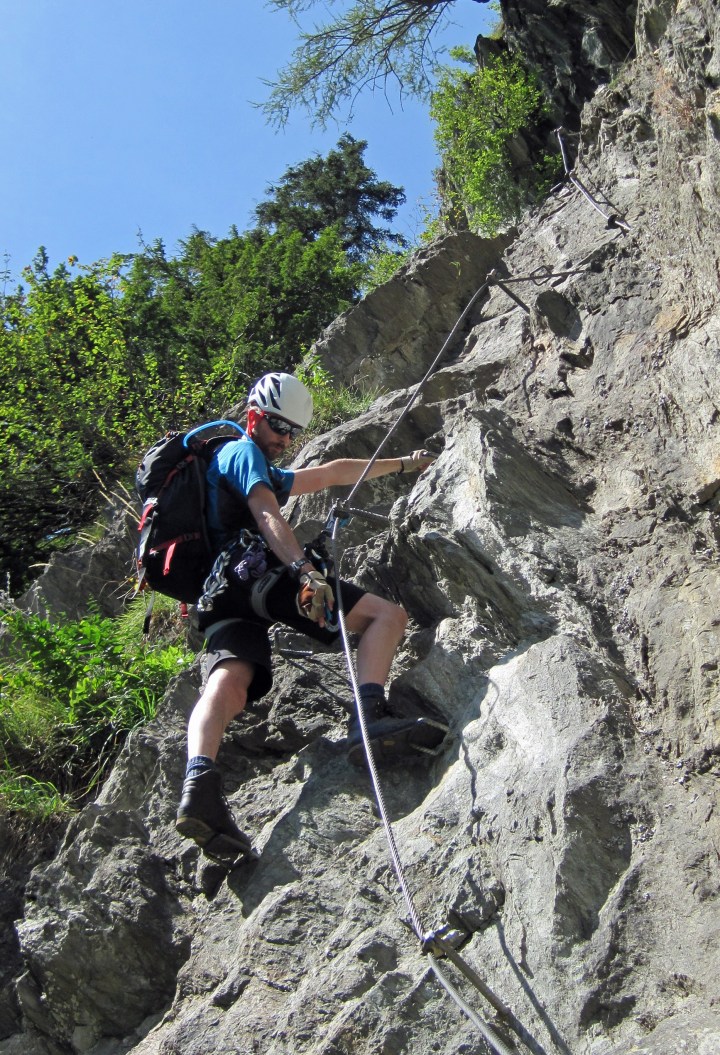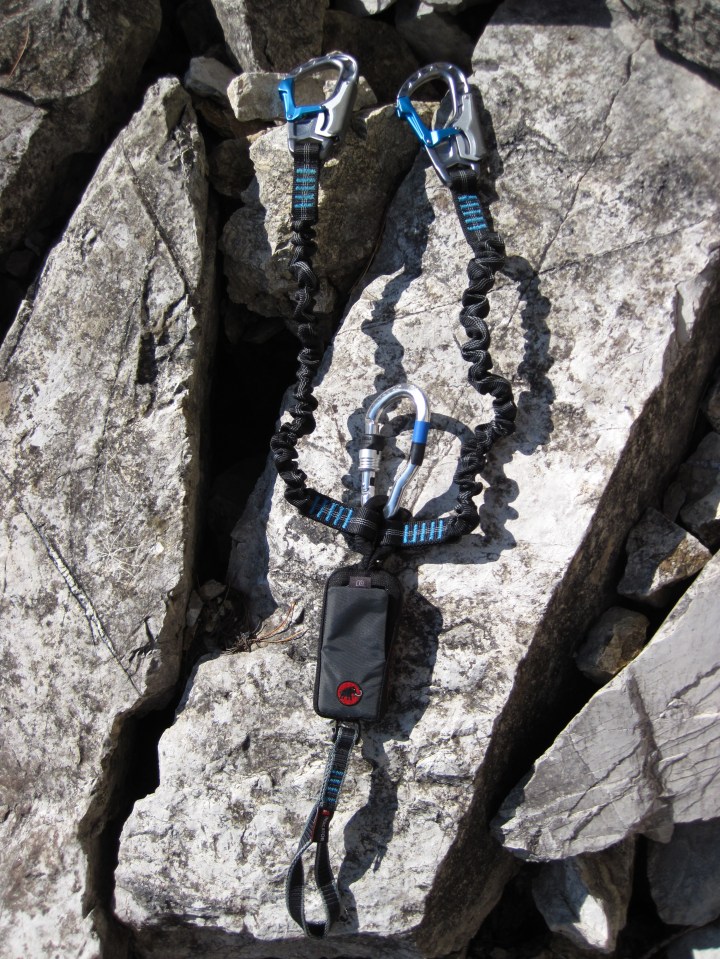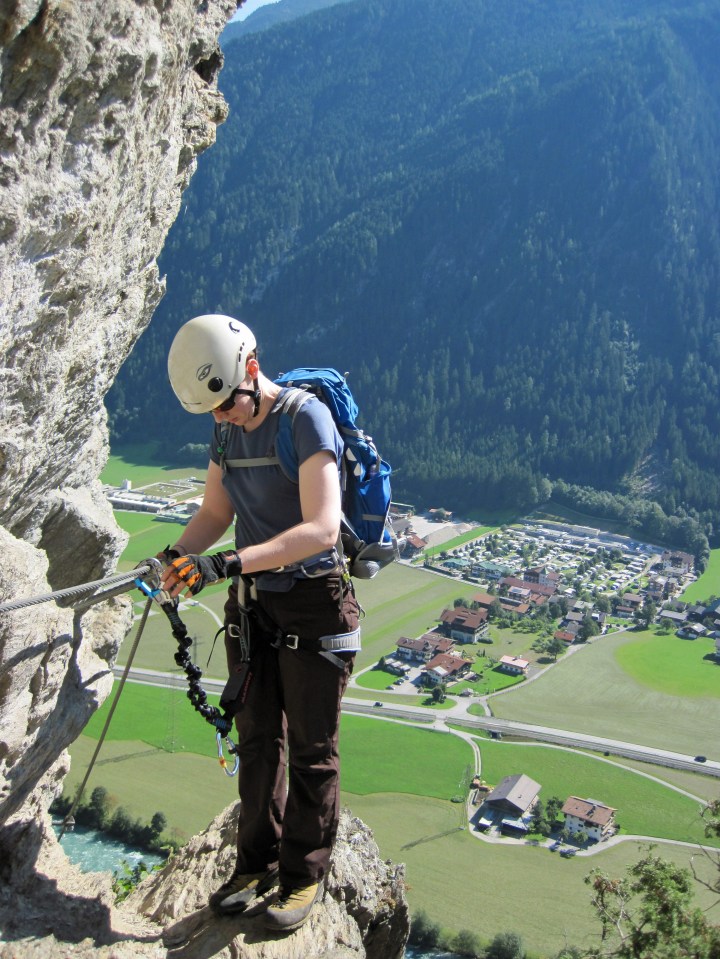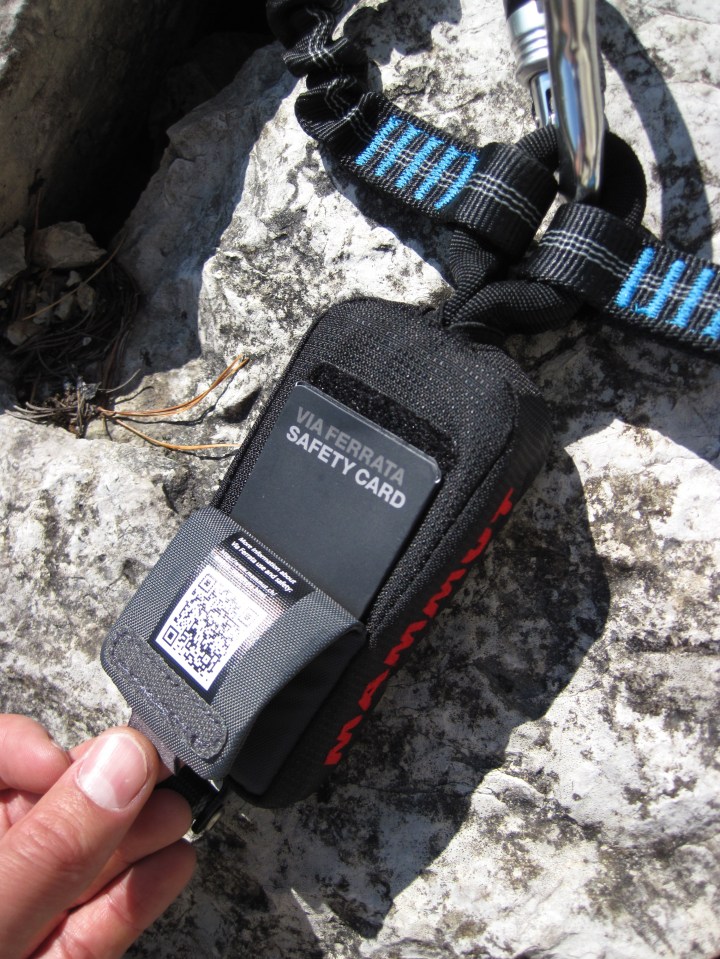The Tec Step Bionic Turn 2 is Mammut’s top-end via ferrata set. It’s robust, handles well and has some brilliant features, but a swivel joint that doesn’t swivel enough and a couple of simple design issues mean that it isn’t perfect.

Two things persuaded me to buy the Tec Step Bionic Turn 2. The first were the strong safety claims made about it by Mammut. The second was the swivel joint designed to eliminate that annoying problem of your lanyards getting twisted during a climb.
Safety
Mammut states that that the Tec Step Bionic Turn 2 “incorporates the most recent findings from safety research” and that:
- the lanyards are of “an extremely strong and robust construction”;
- that the shock absorber that has been optimised to “brake falls even more gently and thus better protect the body”;
- that the maximum impact force of a fall has been reduced; and
- that it will still safely hold a fall “in the case of a 180 degree misuse” i.e. a fall when only one carabiner is attached to the cable.
The last of these claims the one that swung me in favour of buying this model over its competitors. One of the basic pieces of safety advice for via ferrata sets with a webbing shock absorber (such as the Tec Step Bionic Turn 2) is that two carabiners must be kept attached to the cable if it’s going to work properly. The only time that just one carabiner should be attached to the cable is when you have to move each carabiner, in turn, past one of the pins holding the cable to the rock. A fall when you are doing this is a worst-case scenario, particularly if it happens while the leading carabiner is unclipped. Such a fall carries a risk of catastrophic gear failure because it combines potentially high impact forces with a shock absorber being used outside its recommended safety limits. The idea that I would be using a via ferrata set that could cope with this happening was appealing.

While this claim helped persuade me to buy this via ferrata set, my commitment to writing a thorough review is nowhere near strong enough to make me want to check the accuracy of this claim (or any of the other safety claims by Mammut). However, if anyone reading this review every does accidentally fall off a via ferrata while using a Tec Step Bionic Turn 2, please let me know how it went.
Another safety feature (although, strangely not one Mammut highlights) is that red indicator markings above and below the shock absorber bag appear when the shock absorber has been damaged. Essentially, these red indicators are likely to show if a minor slip or fall has caused the shock absorber to partly deploy and so lose some of its ability to absorb the energy of any future fall. If these red indicators are visible, then the via ferrata set is unsafe and should be disposed of. It’s a simple, clever little feature.
The Swifel
The Swifel is Mammut’s name for the swivel joint that connects the shock absorber bag and the tie-in loop on the Tec Step Bionic Turn 2. The aim of this is to allow the shock absorber bag and lanyards to rotate when the set is in use and so prevent the lanyards becoming twisted together. This twisting happens as you move the carabiners past the pins holding the cable and inadvertently, and repeatedly, clip the carabiner that had been trailing on one section of cable as the lead carabiner on the next section. It’s easy to do, particularly if the climbing is hard and you’re focusing on your moves or are so keen to clip the carabiners on the next cable section that you don’t really care what order you clip them in. Getting your lanyards in a twist is annoying because it limits how far you can move each lanyard when you are clipping past a pin.

I found that the Swifel works well some of the time. The lanyards didn’t get twisted at all on the first via ferrata I used the Tec Step Bionic Turn 2 on. However, on other climbs I found the lanyards either got twisted less or as much as other via ferrata sets I’ve used. One possible explanation for this is that how much the Swifel is able to rotate depends on the features of the climb (e.g. how steep it is, how much traversing there is). Another explanation is that the shock absorber is weighted unevenly when an extra carabiner is added to the set (to allow for rests) and this carabiner hangs down on one side of the set more than the other.
This isn’t variable performance great when you consider that you pay an extra £15 for the Swifel. That’s the difference in price between the Tec Step Bionic Turn 2 and the Tec Step Bionic 2, which are identical except for the Tec Step Bionic 2’s lack of the swivel joint. Whether you want to buy one over the other may come down to just how annoying you find getting your lanyards in a twist and whether you are prepared to buy extra for a swivel joint that can reduce, but doesn’t eliminate, the problem.
Other features
This mixed performance with the Swiftel is symptomatic of how the Tec Step Bionic Turn 2 otherwise performs in practice.
On the plus side, the Tec Step Bionic Turn 2 is really nice to use and robust. The carabiners work smoothly and clipping and un-clipping them from the cable is easy. The synthetic rubber on the locking mechanism on the carabiners feels nice in the hand and improves grip. Although the tough outer fabric of the lanyards initially made me think that they would be stiff, they stretch well. The shock absorber bag is compact and so gets in the way less that some other models when climbing. Lastly, I really like that you can add an extra carabiner to the Tec Step Bionic Turn 2 for hanging off the cable to rest, to take a photo or when you want the added security of the set being closer to the cable (e.g. when traversing).
On the negative side, the tie-in loop is only just long enough to allow the Tec Step Bionic Turn 2 to be put on and really needs to be a bit longer. The storage bag is also a tight fit. These aren’t big issues, but they do make it less easy to use the Tec Step Bionic Turn 2.
The last feature of the Tec Step Bionic Turn 2 that it’s worth noting is the puzzling via ferrata safety card that sits in a little pouch on the shock absorber. The Tec Step Bionic Turn 2 already comes with some very good instructions and this safety card is basically a cut-down version of these. Unless you are an absolute beginner with a poor memory, I can’t really see why you would need to refer to the instructions for a via ferrata set in the middle of a climb. What Mammut might have in mind with this safety card are people with little via ferrata experience who rent via ferrata sets while on holiday and so might not otherwise see the instructions. The one useful feature of this safety card is that it includes the phone numbers for emergency services across Europe.

Conclusion
The Tec Step Bionic Turn 2 is well made, easy to use and robust. Mammut makes some strong claims about its safety features and, if true, this is a via ferrata set you can have a lot of confidence in. This is a via ferrata I’ve liked using, but I’ve been a little disappointed with the Tec Step Bionic Turn 2 because the Swifel didn’t live up to its promise and there are a couple of niggles that I wouldn’t have expected in such an expensive bit of kit.


Good review – I’m a Petzl fan, and I’ve found their ferrata kit to be simple and uncomplicated.
Thanks Paul.
I think the miniature attached prompt card attached to the set is a good idea but, in order for me to see something that size, I’d probably also need a spectacle clip adding too!
I’m about to find out all about falls tomorrow as I’m off on my lead climbing course at the wall!
Love your the bit where you’ve asked:
“However, if anyone reading this review every does accidentally fall off a via ferrata while using a Tec Step Bionic Turn 2, please let me know how it went.”
The experts do say that learning how to fall when trad climbing is important so as to overcome the fear of falling as this fear may hold you back. I understand the point, but I’m not entirely convinced I want to practice falling off. I’m even less convinced by the argument when I’m actually climbing. Hopefully you won’t experience the fear of fall or actually fall on your course tomorrow.
I’m glad you liked the request for reader feedback. Although I would be interested in any answers to the request, hopefully no one will ever be in a position to reply.
I do need to work on my resistance to falling a bit. I’m always seconding and single-pitching and, as such, I’m pretty much not going to go anywhere when I fall off but am still reluctant to do it for some reason!
The only thing worrying me is that I’ve just had a bad back and it’s only just got better and I’m worried the larger falls tomorrow might upset it again. We apparently work up from smaller falls and, if I find they bother my back, I’m not going to do any more falls!
That sounds like a good plan. It’s meant to be practice, not the real deal that lands you in hospital.
Good luck.